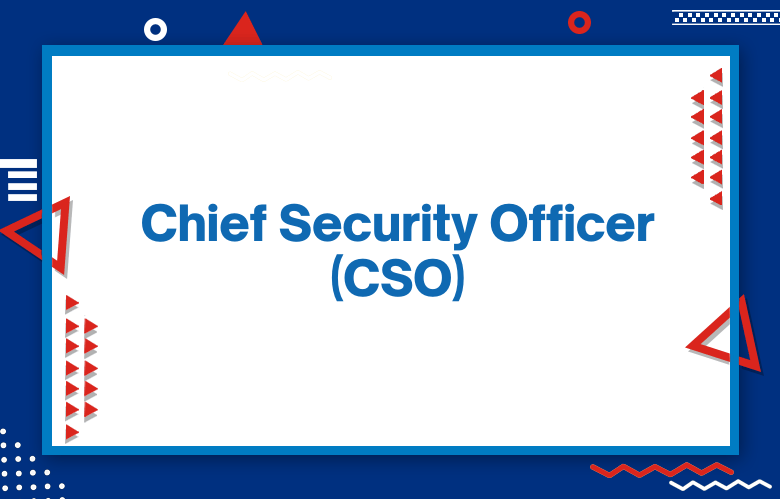Chief Security Officer (CSO): Challenges of Chief Security Officer Security

Chief Security Officers (CSOs) are responsible for their company’s security and information. TheyCSOs must be vigilant about protecting digital assets to prevent costly breaches. Still, they also need to work with other departments, such as marketing, HR, and finance executives, to ensure that IT is not considered an impediment.
CSOs can help make your company more secure by working with your employees. We’ll discuss how you can use these tips to get buy-in from other departments without being viewed as a hindrance.
The Chief Security Officer (CSO) secures an organization’s information assets. This includes physical access to a company’s data center, personnel access, and data protection.
As such, it can be overwhelming for anyone to take on this responsibility alone. To help CSOs more efficiently serve their organizations, we have compiled some top tips for managing risk.
What is a Chief Security Officer (CSO)?
A Chief Security Officer (CSO) is an executive position that oversees a company’s security policy and programs by its overall business goals.
A Chief Security Officer (CSO) is a high-level executive who oversees a company’s security. CSOs must protect themselves and others from danger and ensure the company’s assets.
A Chief Security Officer (CSO) is a senior executive who leads the organization’s security operations. They are responsible for developing and implementing information risk management strategies and enforcing compliance with laws, regulations, best practices, and standards across all technology platforms.
The Chief Security Officer (CSO) leads enterprise security efforts. The CSO evaluates and adopts new technologies to improve a company’s security infrastructure, ensures that IT systems are secure, and works with executives and other stakeholders.
Chief Security Officer Security Challenges(CSO)
A company needs to have a Chief Security Officer. They are responsible for the safety of their employees and everyone with access to their information systems, so they should be given the highest priority regarding security issues.
Understanding CSOs is a crucial part of business management. They are responsible for securing company data and assets from internal and external threats.
CSOs have to face many security challenges. For example, the director of a company may not be fully aware of all threats.
A CSO is an organization’s Chief Security Officer. This role requires a person with significant experience in security who can make high-level strategic decisions to reduce risk and mitigate threats to the organization’s infrastructure.
The Chief Security Officer is vital in the relationship between an organization’s management and IT department. Their job is to ensure that Information Technology issues do not negatively affect an organization’s business goals or reputation.
- Protect your perimeter
- Keep a close eye on the inside of your network.
- Secure all the devices connecting to your network
- Installation of antivirus software and update it regularly is required
- Monitor for unusual activity in real-time
- Cyberterrorism
- Data theft
- Viruses and malware
- Phishing scams
- Hacking attempts to steal information or take down websites
- Security breaches happen, and they can be costly
- The average data breach costs $5 million to fix, so you need a plan before the hack happens.
- A security strategy should include prevention, detection, response, and recovery.
- Prevention includes firewalls, antivirus software updates, and avoiding risky online behavior like clicking on suspicious links or opening attachments from unknown senders.
- Detection involves monitoring systems for abnormalities or any signs of an attack- this is also when you would use your backup system if one exists.
- The response includes notifying authorities immediately after detecting the intrusion- it’s essential to act quickly because cybercriminals can steal personal information within minutes of gaining access to your network.
- Cyber-attacks
- Data breaches
- Hacking attempts on your network and data systems
- Insider threats from employees with malicious intent or disgruntled ex-employees seeking revenge
- Unauthorized access to sensitive information by outside actors, including competitors and nation-states
- Security challenges are constantly changing.
- We must be careful with social media because it makes a company more vulnerable to attacks.
- Employees can be the root of security issues, so we need to make sure they know what is acceptable and what isn’t
- Cyberattacks happen all the time- companies need to stay on top of them
How to become a Chief Security Officer?
The Chief Security Officer (CSO) is an executive-level position with one of the highest salaries, so it’s easy to see why it attracts many aspiring candidates.
The Chief Security Officer (CSO) is an organization’s top-level executive or board member who oversees and implements security standards and practices.
CSO is a profession that requires a business-like attitude. To become an effective CSO, learn how to conduct yourself in meetings and think about the bigger picture rather than each case.
The Chief Security Officer (CSO) is responsible for protecting the integrity of a business’s assets. The CSO must ensure that both human resources and technology are secure.
Chief Information Security Officer (CISO)
CISO is one of the most respected roles in IT. It incorporates leadership, management, technology, and information security skills.
The role of a CISO is to supervise the security of an organization.
Though the CISO is not a board-level position, they are one of the most critical employees within an information security department.
The Chief Information Security Officer (CISO) is an organization’s information security head who ensures that all measures are taken to protect sensitive data from loss or theft.
Nowadays, ensuring that your business has an excellent hacking policy is essential. If you don’t have one, consider contacting an information security officer (CISO) to help protect you from cyber-attacks.
Chief Security Officer Roles & Responsibilities
A CSO is the primary and final level of security management. Their job entails creating, implementing, managing, and monitoring an organization’s comprehensive security program.
A CSO is the primary and final level of security management. Their job entails creating, implementing, managing, and monitoring an organization’s comprehensive security program.
The Chief Security Officer is the head of the company’s security department. They are also responsible for all IT systems, operations, and policies. They generally protect the company from internal or external threats to its physical assets and intellectual property.
The Chief Security Officer is responsible for overseeing an organization’s information security. Like Chief Information Officers, they focus more on information assurance and less on technology implementation.
- Protect the company’s assets.
- Assess and mitigate risk.
- Develop security policies, procedures, and standards for the organization
- Develop training programs to ensure that employees are aware of risks and how they can protect themselves from harm
- Conduct penetration testing on systems to find vulnerabilities or weaknesses in the system before hackers do
- Protect the company’s information, assets, and people
- Manage the organization’s security operations
- Develop a risk management strategy for the company
- Implement a security policy that complies with legal requirements and industry standards
- Monitor all aspects of IT systems to identify breaches or vulnerabilities in data protection
- Develops and implements security policies
- Ensures the protection of company assets, including information technology systems and data
- Oversees all aspects of physical security for the company’s facilities, equipment, personnel, and operations
- Coordinates with outside law enforcement agencies to prevent terrorism or other threats to public safety
- Developing and enforcing security policies
- Monitoring the network to detect intrusions, unauthorized access, or misuse of resources
- Planning for emergencies by creating contingency plans and disaster recovery strategies
- Training employees in security procedures and practices
- Design and implement security policies
- Monitor security systems to maintain compliance with regulations, such as the Health Insurance Portability and Accountability Act.
- Perform vulnerability assessments of networks and applications; monitor network traffic for potential malicious activity.
Conclusion
As the Chief Security Officer at ABC Company, I protect my team and company from cyberattacks. To do so, I have implemented several software programs that monitor our network 24/7.
One such program is a firewall that screens all inbound and outbound traffic to ensure no malicious content enters or exits the system. The other tool we use is IDS systems (Intrusion Detection Systems), which identify unauthorized access attempts by hackers and block them before they cause any damage.
Call: +91 9848321284
Email: [email protected]



